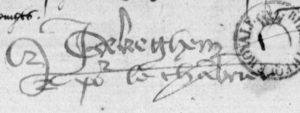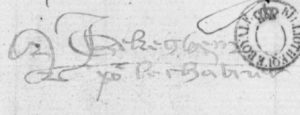Ockeghem – or Okeghem?
Johannes de Okeghem was born around 1420 in the small town of Saint Ghislain, near Mons, in the county of Hainaut and in the diocese of Cambrai. Saint Ghislain lies in modern-day Belgium, about 40 miles southwest of Brussels and less than ten miles from the present border with France.
The county of Hainaut or Hainault was a lordship within the Holy Roman Empire with its capital at Mons (Bergen in Flemish); the name comes from the river Haine. Hainaut comprised what is now the Belgian province of Hainaut and part of the present French département of Nord, and included the cities of Charleroi to the east of Mons and, to the southwest, Valenciennes and the diocesan seat of Cambrai, both in latter-day France. In 1420 the county was ruled by Jacqueline, daughter of duke Wilhelm II of Bavaria-Straubing, but in 1432 it was ceded to the Duchy of Burgundy under Philip the Good; upon the death of Charles the Bold in 1477 it passed to the Habsburgs along with the rest of the Burgundian Netherlands.
The composer’s given name was Jehan or Jean, or Johannes in Latin or other non-French contexts. The surname suggests that his family originated in the town of Okegem on the Dendre in East Flanders, about 35 miles to the north of Mons. But Hainaut was culturally and linguistically French, and Jehan most likely grew up speaking French as his first tongue. By the mid-1440s he was living and working in France, and from about 1450 until his death in 1497 he was a member of the chapel of the the king of France and lived in the city of Tours in the Loire Valley.
The composer’s Flemish family name was a source of endless confusion to speakers of French, Italian, German, and other languages, and it may be found spelled in a bewildering variety of ways in contemporary manuscripts: Okeghem, Ockeghem, Okegheem, Ockegheem, Okeghen, Okeghan, Okenghem, Ockenheim, Okekam, Obekhan, Obergan, Hockeghen, Hoquegan, Hocquergan, Hoiquergan, Holreghan, Okegus…. A 19th-century historian of Tours, Eugène Giraudet, reproduced a presumed autograph signature in his book Les artistes tourangeaux but failed to indicate the source, which remains unknown.
Eugène Giraudet, Les artistes tourangeaux (Tours, 1885), p. 312
Modern scholarship has generally accepted the authenticity of the signature, but disagreed about exactly what it said. One might well read the signature in Giraudet’s facsimile as “J Oekeghem,” but some scholars have argued that what appears to be an e is in fact an unusually formed c. This line of reasoning has led to the general acceptance of “Ockeghem,” despite the fact that the spelling “Okeghem” is the one by far most frequently found in contemporary documents from the French court (where the composer worked) and the Papal chancelery (where numerous documents survive that deal with benefices assigned to him), as well as in song sources from central France. On the other hand, the spelling with c is lent some support by the Chigi Codex. Copied in the Low Countries not many years after the composer’s death, the manuscript is the single most important source of his Masses and the unique copy of four of them. Here ten out of thirteen ascriptions above individual works spell the name “Ockeghem”; one reads “Ockegem” But two read “Okeghem” and the index, added later by a Spanish scribe, gives “Okeghem” fifteen times.
There the matter rested until very recently, when David Fiala, a scholar at the Centre d’études supérieures de la Renaissance at the University of Tours, located two documents in the Department of Manuscripts at the Bibliothèque nationale de France. They are a pair of receipts, dated July 8th and 9th, 1480, which Okeghem signed in his capacity as canon and treasurer of the collegiate chapel of Saint-Martin of Tours, in the absence and in the name of his colleague Geoffroy Chyron, the college’s chambrier or chamberlain, responsible for its finances.
Paris, Bibliothèque nationale, MS fr. 2904, f. 28
Paris, Bibliothèque nationale, MS fr. 2904, f. 29
According to Fiala’s interpretation, the first component of the signature is a capital O crossed by a capital J; the O itself is formed from two strokes, the righthand one of which is also the stem of a lower-case d. (The loop to the left is an ornament to the stroke which underlines the signature itself, and has no alphabetical meaning.) The combined J-d-O is followed by the letter e, then “keghem”: thus, “J de Okeghem.” Voilà!
Okeghem@600, anyone?
To see the signatures in their original context:
receipt of July 8, 1480
receipt of July 9, 1480
Read David Fiala’s article:
David Fiala, “La très véritable signature de J. de Okeghem et ses implications philologiques,” Revue de musicologie 105 (2019): 1, pp. 145-58.





